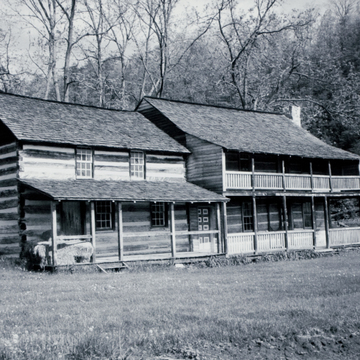This is West Virginia's vernacular architectural image incarnate: a wonderfully informal, picturesque log house with ample porches and just enough of a patina to appear slightly shabby. Actually the house is two separate two-story log structures joined by a dogtrot. A two-tiered porch covered by a continuation of the gable roof fronts the larger north section, whereas the lower, shorter south section has a one-story, shed-roofed porch. Massive fieldstone chimneys stand at both ends.
The migrations of the builder, John (Johanne) Mathias, demonstrate settlement patterns typical of the area's first inhabitants. A native of Alsace-Lorraine, Mathias emigrated to Philadelphia, then moved to Lancaster County, Pennsylvania. From there he moved to Frederick County, Maryland, then crossed the Potomac to the Shenandoah Valley in Virginia. He finished his peregrinations when he crossed the Alleghenies to Lost River Valley, where he acquired land in 1791.
According to tradition, bolstered by its location at an important early crossroads, the house served as an inn as well as a residence. Mathias's descendants lived here until 1960, and the Mathias Civic Center Association acquired the house in 1974. The building was in deplorable condition when it was listed on the National Register of Historic Places in 1978, but it was





